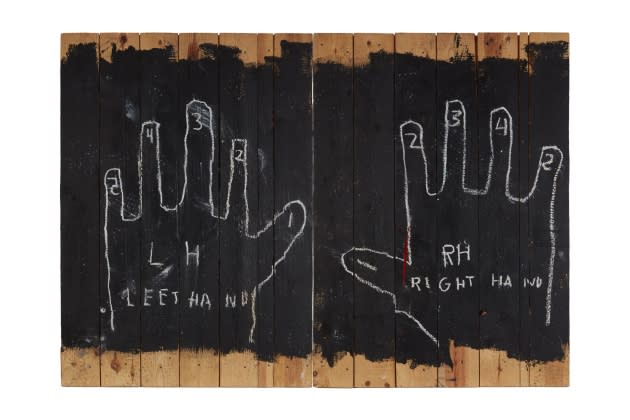The Sounds of Basquiat
- Oops!Something went wrong.Please try again later.

Young, beautiful and immensely talented, Jean-Michel Basquiat’s meteoric rise from hungry outsider to star of New York’s ’80s art scene was a wild ride as he staked his claim to art world fame.
But since his death from a heroin overdose at the age of 27, Basquiat has left both fans and foes wondering what might have been had the graffiti artist turned genre-wrecking master of the canvas lived to old age.
More from WWD
Now the Montreal Museum of Fine Arts is fanning that curiosity and much more with the debut of “Seeing Loud: Basquiat and Music,” the first large-scale, multidisciplinary exhibition devoted to the role of music in the work of one of the most innovative artists of the second half of the 20th century. The exhibition opens Oct. 15 and will run to Feb. 19, 2023.
Beginning with an exploration of the music that shaped Basquiat’s life and New York City in the ’70s and ’80s, the show, which was organized by the MMFA and the Cité de la musique — Philharmonie de Paris, presents more than 100 works by the artists along with numerous sound clips, film footage, notebooks and archival documents that shed new light on his career as a painter, performer and musician, most notably with the band Gray, which he helped launch.
The exhibition also features an app that will allow visitors to see these works in the original settings they were first shown in.
Yet the exhibition “is more than just a soundtrack to his life,” says Mary-Dailey Desmarais, chief curator of the MMFA and co-curator of “Seeing Loud.”
“Basquiat made sound visual,” she adds.
“As a Black artist, Basquiat used the musicality of his work to address the cruelties of the world and call out social injustices of his day. So if people leave this show thinking Basquiat listened to a lot of music, that’s great. But what we really want is for people to understand the extent music affected his art — and that will be a revelation.”
An American born to Haitian and Puerto Rican parents, Basquiat listened to a wide range of musical genres, including jazz, hip-hop, bebop and opera.
“He had a collection of 3,000 records and this is the first time that audiences will able to immerse themselves in the music Basquiat listened to,” says Vincent Bessières, guest curator of the Musée de la musique — Philharmonie de Paris.
“But in a broader sense, I think audiences will see that Basquiat was addressing issues that are still relevant and contemporary 40 years after his death,” Bessières adds. “Basquiat called out police brutality, which is still a big issue in our society today. He was also concerned about global warming and how much oil was at the center of art and our lives.
“Back in the 20th century, musicians made records out of oil. Painters used materials made of oil and were dependent on these things. Basquiat noted all this long before today’s eco culture and was ahead of the game in the way he responded to it with his art.”
The prolific, multidisciplinary artist also collaborated on several videos, produced an album and designed the flyers announcing musical performances in New York at a time when the city witnessed one of the most creative periods in its musical history.
Since Basquiat’s death, his work, which once sold for a few hundred dollars, has soared into the millions.
In 2017, for example, the 1982 work “Untitled” depicting a black skull with red and yellow rivulets, sold for a record-breaking $110.5 million, becoming one of the most expensive paintings ever purchased.
Best of WWD
